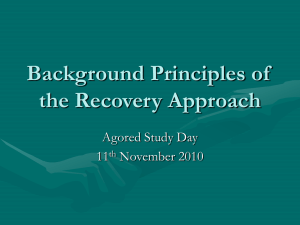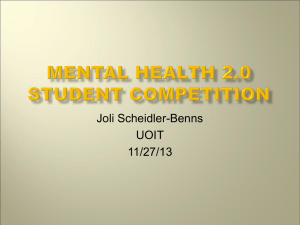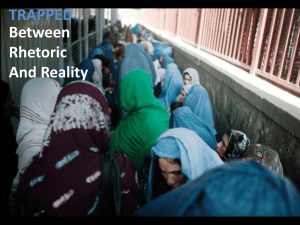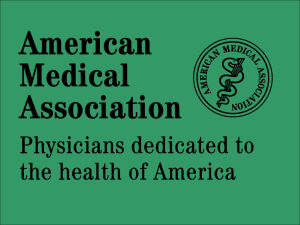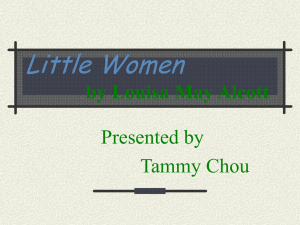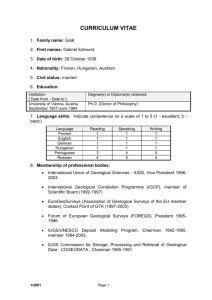Australian Mental Health System
advertisement
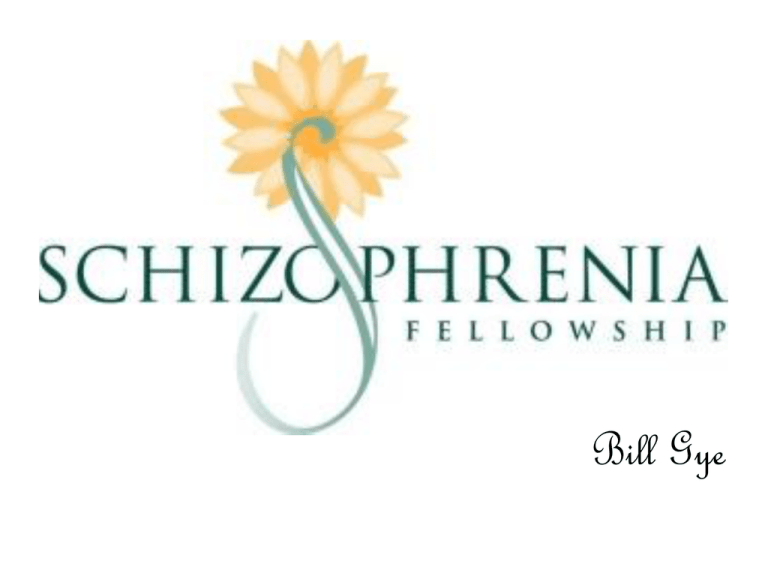
Bill Gye Clifford’s Story The history of the treatment of people with mental illness is full of cruelty and compassion Psychological Medicine / Volume 22 / Issue 01 / February 1992, pp 131-145 Copyright © Cambridge University Press 1992 The International Pilot Study of Schizophrenia: fiveyear follow-up findings RESULTS Clinical and social outcomes were significantly better in third world countries than those in developed countries. J. Leff, N. Sartorius, A. Jablensky, A. Korten and G. Ernberg World Health Organization, Geneva, Switzerland IMPACT W.H.O. Global Morbidity Study (Productive Years lost for 15-45 year olds) MentalMental Illness Illness* Injuries Injuries, including self-inflicted Alcohol drug use Alcohol &andDrugs Cancer Malignant neoplasms (cancer) Cardiovascular disease Cardiovascular disease Respiratory disease Respiratory disease Musculoskeletal Musculoskeletal disease SenseSense Organ disease organ disease Digestive disease Digestive disease 0 5 10 15 20 25 30 35 Mental Illness and Mortality 1. In Australia at least 2,000 people per year die from suicide, 90% related to mental illness – Cf. Road accident deaths = 1,193 (2013) 2. People with severe and persistent mental illness die 20-25 years earlier than average Mental Health in Australia: a Review of Expenditure and System Design Summary of DIRECT health expenditure to support people with mental illness $ 13,829 Summary of NON-DIRECT health expenditure to support people with mental illness $ 14,757 Health expenditure to support people with mental illness Annual Expenditure $1M $ 13,829 Direct Indirect $ 14,757 Total $28,586 Mental Health Service Channels Some Drivers of the Future Direction of Mental Health Services in Australia • National – National Disability Insurance Scheme (NDIS) – National & State Mental Health Commissions Plans • International – Mini-breakthroughs from Research Initiatives such as the NIMH’s Research Domain Criteria (RDoC) – International Consumer and Carer Movements and ongoing efforts at De-stigmatisation Schizophrenia Research Volume 127, Issue 1 , April 2011 Moving ahead with the schizophrenia concept: From the elephant to the mouse Several converging lines of research are deconstructing the entity of schizophrenia, into overlapping components and dimensions The Fellowship • 60 sites across NSW • 250 staff (a significant proportion are consumers or carers) • 500 volunteers • 3,000 members • Enmeshed in numerous service networks • Funded by a patchwork of State & Federal Grants and Contracts • Partners in several research projects • Own Research Trust Fund • Key partner of the Australian Psychosis Research Network • Part of the Mental Illness Fellowship of Australia (MIFA) What do we do • • • • • • Advocacy and Influence Bring the service to the people At home, in the community, phone, online, etc. One to one and/or in groups Health, Housing, Employment, inclusion, etc. There is a very fuzzy boundary now between “clinical work” and “community support” Shifting Politics • • • • Reversal of traditional hierarchies Empowerment Uniqueness At the edge – greater tolerance of diversity and “deviance” • Recovery Approach “Psychosocial Recovery” Two Definitions: Being able to live a meaningful and contributing life with or without the presence of mental health issues OR Where a person feels and believes that they are making progress in one or more areas of life that are significant to them Macro view of Cycles and Interventions To Break the Remission Cycle Crisis Long term problem unaddressed Discharged Admission to Emergency Department Scheduled in Psychiatric Ward Circuit Breaker Crisis (i.e. harm to self or others) Address problems to prevent Crisis Long term problem unaddressed Discharged Admission to Emergency Department Scheduled in Psych Ward for 1+ days Recidivism Cycle Crisis (i.e. Crime) Long term problem unaddressed Released Arrested Detained Self-Perpetuating Illness Cycle Stress and negative emotion Not meeting needs in area(s) of life Inability to function well Vicious Cycle Vulnerable Person Aggravation of brain disorder Shift into a Benign Cycle Decreased Stress Meeting needs in life Functioning Improved to better meet own needs Recovery Cycle Vulnerable Person Neuroplastic Repair Intervention Points Psychological Techniques Decreased Stress Social and Practical Support Meeting needs in life Skills and Initiative Development Functioning Improved to better meet own needs Recovery Cycle Vulnerable Person Neuroplastic Repair Early Identification Improve Physical Health SFNSW and ARC Centre for Excellence in Cognition and its Disorders Some wild ideas…. Belief Formation Stage 2 Belief Evaluation The power of a “trusted peer group” to strengthen: (a) weak or dysfunctional belief evaluation processes and/or (b) alternative (competing) beliefs Trust • The slow development of interpersonal trust, increases trust in other views • If much thought is “internal” conversation, the development of a more benign “internalised other” is a key component of improved meta-cognition • I.E. Put a dysfunctional individual in a functional group they can trust and the dysfunction begins to self-correct Belief Formation – Stage 1 • Stage 1 involves impairment of perceptual or interpretative processes • A component of the above can be anomalous experience • These may consist of voice hearing; hyperaesthesia; synaesthesia; mystical experience; hypnogogic experiences; lucid dreaming, etc. • By acknowledging, discussing and sometimes even valuing these experiences it is possible to decrease anxiety and increase more realistic meta-cognition in relation to them • E.G. Voice Network movement (www.hvna.net.au) Language 1. Accessible usable online procedures for assessing language disorders (from the grammatical to the “pragmatic”) and tailored individualised remediations 2. It is hypothesized that “voice hearing” is a break down of the “efference copy” when “thinking in words”, – – This begs several questions such as whether “thinking in words” is an implicit language activity More light needed on the possible role of the Efference Copy dysfunction in the experience Voice Hearing Memory • Why the process of “benign forgetting” (usually during sleep) to “clear the emotional slate” is diminished and how to restore it. • What’s needed to shift emotionally charged episodic memories into less emotionally charged autobiographical memory. • What is the relation between not being able to forget negative events and an overly active negative scenario imagination Person Perception • Are disorders of person perception in people with “schizophrenia” primary disorders (i.e. causative) , OR are they... – downstream effects of social hyperaesthesia & anxiety and leading to habits of perceptual avoidance – Manifestations (or symptoms) of more general sensory processing disorders We need: • Continued research on the underlying biological factors and epigenetic triggers • Global models of cognitive function that combine social, affective and general cognition • Accessible online procedures for assessing specific cognitive functions and tailoring individualised cognitive remediations What really need: • A usable evidence-based macro-theory of human functioning. A bio-psycho-social Theory Of Everything (TOM). The equivalent of the Standard Theory in Physics. Dymphna’s Story The Town of “Geel” in Belgium GEEL The Social Component of the Bio-Psycho-Social Model • A Group = family, peer group, work team, community, etc. • A dysfunctional group is one with too much conflict, little altruism or coordination to achieve common goals. • A functional group is the opposite • A dysfunctional group can trigger and amplify potential dysfunction in vulnerable individuals • Put a dysfunctional individual in a functional group setting and the dysfunction often self-corrects Geel • • • • • St. Dymphna is the patron saint of the mentally ill, psychologists and psychiatrists. Dymphna was born in the early 7th century of the King and Queen of Oriel in Ireland. When she was 14 years old, her mother died. It is said that in the aftermath of her death her father’s mental health sharply deteriorated and he desired to marry his daughter who resembled her mother. Dymphna fled with two servants and a small sum of money to the town of Geel in Belgium where she built a hospice for the mentally ill. The bad news is that her father tracked her down and killer her. The real punch line is that the tradition of supporting the mentally ill continued on in Geel. For at least the last 700 years the people of the town have taken the mentally ill from all over Europe into their homes as guests. In Geel the term for people with mental illness is “boarders”. A boarder is treated as a member of the family and involved in everything, including work and child care, and may live with the family for years, or even a lifetime. In 1794 Philippe Pinel, the founding father of French psychiatry, who was legendary for ‘striking the chains off the mad’ at the Salpetrière asylum in Paris, wrote in his “Treatise on Insanity” that ‘the farmers of Geel are the most competent doctors in France and provide the only reasonable treatment of insanity‘. By the late 1930s, there were almost 4,000 boarders among a total population of 16,000. Sadly today, there are only 300 boarders now in Geel. What changed was the economy. Families no longer work on the land or need help with manual labour. Most citizens are now employed in the business parks outside the town and the march of modernity has irreversibly loosening traditional community ties and customs. Clifford Beers • In 1876 Clifford Beers was born in Connecticut USA as one of five children, all of whom would suffer from mental illness and all died in mental institutions. • In 1897 at the age of 21, Beers graduated from Yale with honours. • In 1900 to 1906 he was confined to several mental institutions for depression and paranoia. During these periods he experienced significant trauma and torture, including 21 days in a Straight Jacket and other forms of confinement. He also experienced many kindness and fellowship. • In 1908 his autobiographical book A Mind That Found Itself became a bestseller. • In 1909 he founded the "National Committee for Mental Hygiene", now named "Mental Health America". • In 1913 he opened the first outpatient mental health clinic in the United States and became the Honorary President of the World Federation for Mental Health. • He died in 1943. The history of the social treatment of people with mental illness is full of cruelty and compassion

